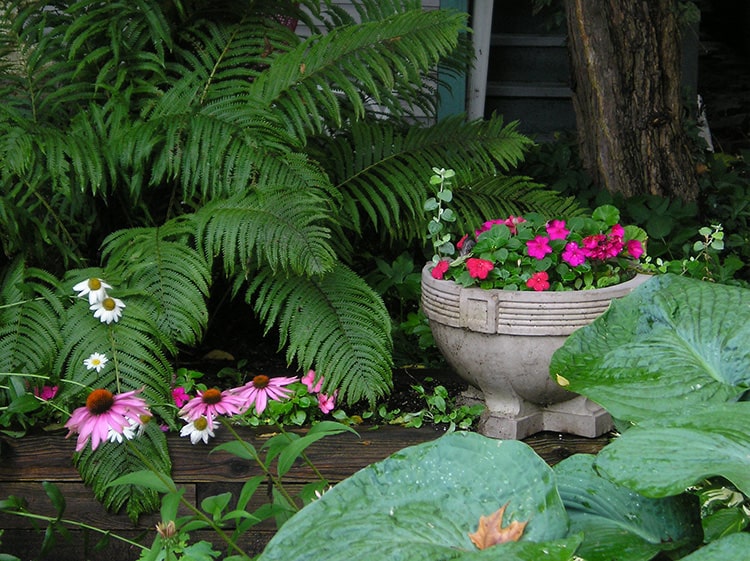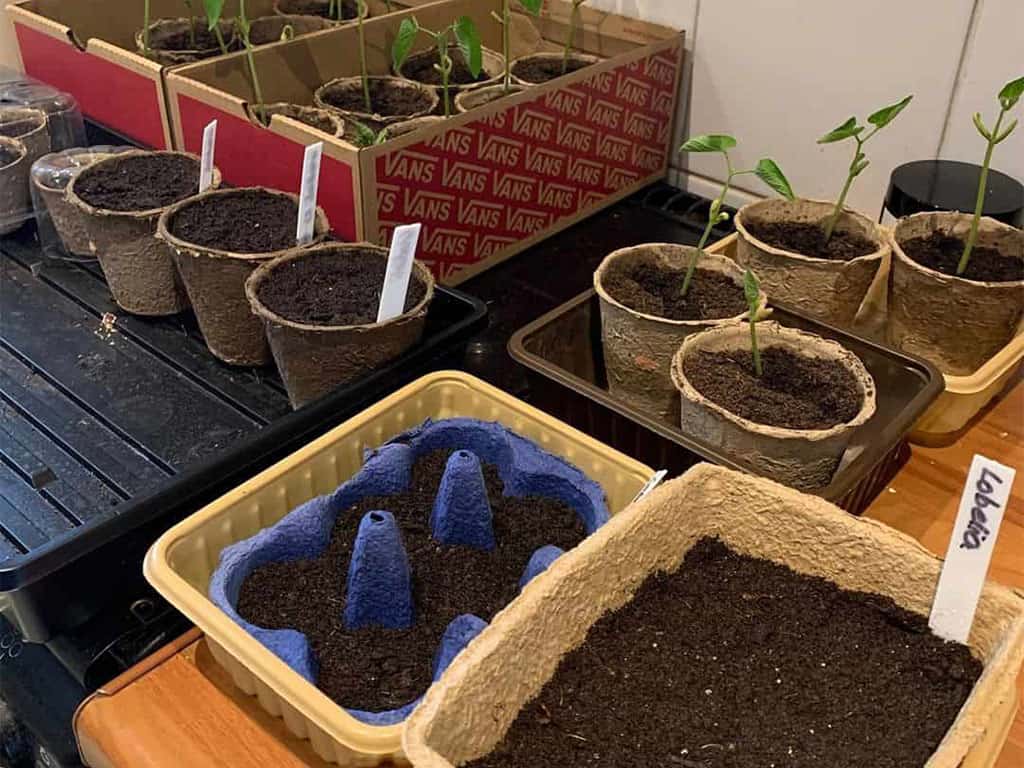The passionflower grows wild in South American rainforests but it will also grow happily in a pot in the UK, provided it’s placed in full sun and you give it lots of fertile soil.
However, be warned… a passionflower vine can climb as high as 16-20 feet in a pot (or even higher), so it may throw shade on any other nearby plants. Give some thought about where you place the pot.
Read on to find out how deep the pot needs to be, the types of passionflower available, which varieties produce fruit, and why it’s called a passionflower.

Image credit: @northhavengardens
Can you grow passionflower in a pot?
Definitely. In fact, the pot will help to contain some of its growth and, as passionflowers are considered invasive in some parts of Latin America, the pot may save it from spreading all over your garden. Passionflowers are perennial so the plant will come back year after year if you look after it well. If you buy your plant from a nursery, check if the roots are trying to escape the pot and if so, re-pot it immediately.
Provide the passionflower with a pot that’s at least 1 foot deep, although a pot double this size will promote more vigorous growth. Although passionflower has shallow roots, it will spread everywhere. You will need to mulch the pot every year with fresh compost and leaf mould to encourage the exotic blooms.
How to grow passionflower in a pot

The passionflower’s curling tendrils will attach to surrounding plants and supports. Image credit:@abi_ellison_barker
Passionflower will bloom every day from July to October given the correct conditions. The stunning flowers are a complex mix of white or lavender petals, a corona and vivid stamens. Here’s what you need to consider when growing a passionflower in a pot.
- Use a deep, heavy pot. Think of how high this plant can grow and remember that all its nutrients come from the soil inside the pot. A passionflower vine can become quite unsteady as it climbs so place a few heavy stones in the base of the pot to aid drainage and provide some weight.
- Fill it with nutrient-rich soil. The soil needs to contain plenty of nutrition in order for flowers (and fruit) to develop. Give it good drainage and make sure the soil contains some grit. In the wild, passionflowers benefit from the nutrients released by rotting leaves in autumn. If you make your own leaf mould, add a top layer to the soil in the pot.
- Support your passionflower. As a vigorous climber, support is essential. Wire, trellis, and bamboo will all be suitable but make sure you set this up before the plant begins to grow in late spring. As the stems grow and flowers appear, the plant will attach itself to anything close by using its tendrils.
- Deadhead regularly. Passionflower blooms regularly, although total removal of flowers will prevent fruit from forming so if you enjoy harvesting, allow a few to turn into fruit first.
- Water carefully. Passionflower grows under the tree canopy in the wild so it is used to downpours which soak the plant and then drain away. Water the plant thoroughly, allowing the excess to soak away, and ensure that there is good drainage. Water again when the soil is dry. If you water too often, the roots will rot so check the soil and if it feels dry, give it some water. Drooping leaves are another sign that the plant needs water. Remember not to water often when the fruit has formed because the plant goes dormant for a few months in the cool period. Just water it if it looks very droopy during the winter.
- Feed when fruiting. Feeding isn’t usually required if you’ve changed the soil in spring but when the plant is fruiting, a comfrey feed will help to produce plumper fruits. Add a few comfrey leaves to a bucket of water and leave to soak for a few days, then water the passionflower with the mixture every week in late summer.

Image credit: @buckinghammarkets
How to prune a passionflower plant in a pot
Late autumn or early winter is the time to prune, particularly if you’re moving the pot into a more sheltered space indoors during the winter. Some gardeners prefer to prune in spring but I think it makes more sense to do it before you move it indoors, for ease of management.
- Sharpen your cutters well and then remove as much growth as you like from the top as the root remains intact and will grow happily anyway. Allow at least a foot of actively growing branches at the base which have some leaf growth. It will look a bit sad but by next summer, you’ll hardly know it was pruned.
- Make sure you leave some branches with leaves closer to the roots. Cutting the plant back gives it time to recover indoors and you can add a mulch of new compost to the pot too.
- Place your passionflower in a warm place and water it occasionally because the plant is almost dormant in winter. As soon as the danger of frost has passed, put it outside on sunny days to acclimatise to a new growing season and then leave it in its permanent position from late May onwards.
What’s the growing season for passionflower?
As soon as the frost is gone, you can place your passionfruit pot outdoors. This plant is a sun lover so make sure to trim back any tall shrubs near it to allow it to find the sun. From May onwards, the pruned shoots will start to produce vines, which will climb really quickly. Fantastic next to a garden shed in full sun, it will cover the whole shed with foliage, buds, and flowers within a month.

The passionflower is a vigorous climber. Image credit: @raderbeans
By June you should have flower buds and you will soon notice new exotic flowers every few days. Remove the dead flowers and keep watering in hot, dry weather and when the soil dries out. As fruit starts forming, you can add a top dressing of compost or a feed but if you provided fresh soil in spring, this isn’t essential.
Which varieties of passionflower can I grow in the UK?
There are over 400 species of passionflower worldwide. Most of them grow wild in rainforest conditions in Latin America, with milder, damper climates so any passionflower you choose for the UK should be able to cope with some colder spells. Another alternative is to move a potted passionflower indoors for the winter and move it back outdoors in the spring when the danger of frost has passed.
- Constance Elliott (Passiflora caerulea) is a favourite in many British gardens for its astonishing floral blooms. I love its tasty fruit but many gardeners find it very tart. Try it before you plant! This variety is reasonably hardy but if you get snow and really cold temperatures, it is wise to take some cuttings and bring the plant indoors over winter.
- Amethyst or Lavender Lady is a variety that produces a purple bloom, similar to the colour of lavender.
- Victoria (Passiflora violacea) offers pink blooms which contrast beautifully with the foliage. It’s quite a delicate variety, so make sure you give it extra protection during winter.
- Different colour fruiting passionflower (Passiflora edulis) comes from Paraguay and it also grows in Argentina and Brazil. Its fruit is usually yellow but some seeds can produce interesting purple fruit and the flowers are really fluffy and exotic. This variety is not hardy so you will need to bring this pot indoors as soon as temperatures drop.
- Inspiration offers deep blue, almost purple flowers. If you have space for two varieties, this is a good choice for contrast.
- Raspberry Strudel is an American variety that flowers in shades of red and pink.

A beautiful red passionflower frames a door. Image credit: @tomzwords
Any problems with passionflower?
- Leggy growth. Pruning should be done either in the autumn or in early spring to remove straggly growth and encourage new healthy branches. You can cut it back quite hard because the passionflower will spread as high as possible come spring.
- Aphids and whitefly love to snack and lay eggs on passionflower leaves and these can be removed by wiping the leaves down with a damp cloth, or spraying a mixture of watery washing-up liquid now and then and wiping the leaves down well afterwards.
- Moths and butterflies will pollinate your plants when you move the plant back outdoors, but they will also lay eggs on leaves. I am reluctant to remove them but you may want to re-locate hungry caterpillars onto other plants close by.
How did the passionflower get its name?
This unusual flower was used by Spanish missionaries to explain the significance of the passion of Jesus at Easter when he was crucified on the cross. The crown of thorns is said to be the corona of the plant, while the filaments were used to demonstrate the crown of thorns that Jesus was forced to wear.
The five petals and the sepals represented the ten faithful apostles. St Peter, who denied him, and Judas, who betrayed him, were not included. Finally, the tendrils which grip onto any support possible are believed to be the whips used to beat the Messiah during his torture.

Image credit: @he_gardens_at_cg
Tina’s Tips
- Deadhead blooms regularly throughout the growing season to encourage more flowering. Leave some on there if you want fruit. Remove any fruit at the end of the season, because if they drop they can germinate and you will have many passionflower plants next spring.
- Top up with nutritious compost every year, as the soil in a pot gets depleted in one season
- Do not water the plant so much in winter, allow it to rest and only water if the soil becomes very dry.
- Prune potted passionflower every year so it doesn’t become leggy. It will not disappoint you the following spring and will grow just as tall again.
Can I eat passion fruit?

Image credit: @eeb.greenhouse
Is passion fruit poisonous? Passion fruit is edible and the delicious, exotic fruits appear in early autumn. The fruit that forms on passionflower plants is oval-shaped to start and its green colour gradually turns to apricot, and finally bright orange when ripe. If you squeeze the fruit and it is soft, then pop one open to try.
The edible part is not the soft “fruit” but the seeds, which are black when you pop open the fruit. These seeds are encased in a ball of yellow or orange pulp, which is sweet and tangy. You can eat them on their own, add them to cereal or fruit salads or serve with ice cream. Passion fruit is a favourite flavour for ice cream and desserts and you will know why when you try it.

Save this pin for later






